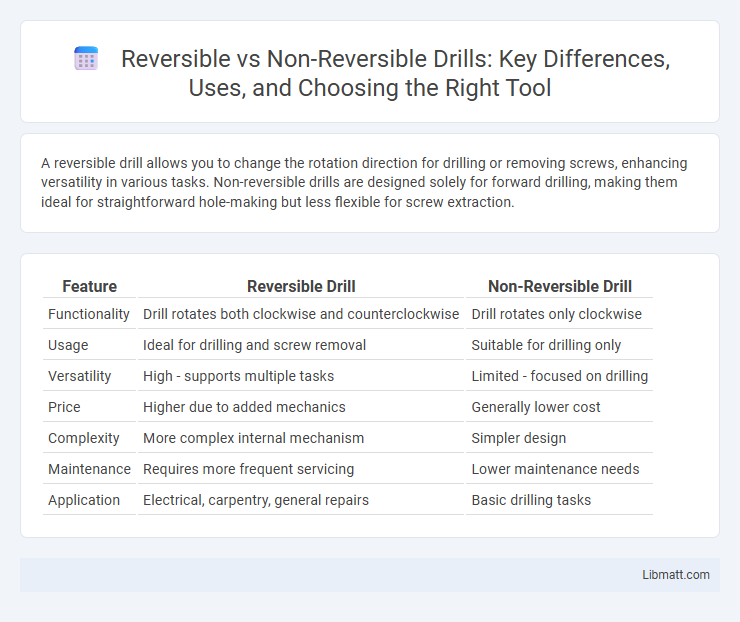A reversible drill allows you to change the rotation direction for drilling or removing screws, enhancing versatility in various tasks. Non-reversible drills are designed solely for forward drilling, making them ideal for straightforward hole-making but less flexible for screw extraction.
Table of Comparison
| Feature | Reversible Drill | Non-Reversible Drill |
|---|---|---|
| Functionality | Drill rotates both clockwise and counterclockwise | Drill rotates only clockwise |
| Usage | Ideal for drilling and screw removal | Suitable for drilling only |
| Versatility | High - supports multiple tasks | Limited - focused on drilling |
| Price | Higher due to added mechanics | Generally lower cost |
| Complexity | More complex internal mechanism | Simpler design |
| Maintenance | Requires more frequent servicing | Lower maintenance needs |
| Application | Electrical, carpentry, general repairs | Basic drilling tasks |
Introduction to Reversible and Non-Reversible Drills
Reversible drills feature a motor capable of rotating both clockwise and counterclockwise, allowing users to easily switch between drilling and screw-driving tasks. Non-reversible drills operate with a fixed rotational direction, primarily designed for straightforward drilling applications. Choosing between these options depends on task versatility requirements and the need for efficient bolt or screw removal.
Key Features of Reversible Drills
Reversible drills feature a motor capable of rotating the drill bit both clockwise and counterclockwise for versatile operation, enabling easy removal of stuck screws and enhanced control during drilling tasks. These drills often include adjustable speed settings and clutch mechanisms to prevent overdriving screws and protect the work surface. Commonly used in woodworking, metalworking, and general construction, reversible drills improve efficiency and precision compared to non-reversible models.
Key Features of Non-Reversible Drills
Non-reversible drills feature a fixed rotation direction, providing consistent torque and stability for drilling into tough materials. Their design typically includes a robust motor and a sturdy chuck, ensuring reliable performance under continuous use. Your choice of a non-reversible drill guarantees straightforward operation and durability, ideal for tasks where backward rotation is unnecessary.
Mechanism of Reversible Drills
Reversible drills feature a motor mechanism that allows the drill bit to rotate both clockwise and counterclockwise, enabling you to switch directions with a simple trigger or switch. This bidirectional rotation is achieved through an internal mechanical switch or electrical signal that reverses the motor's polarity, providing greater control for tasks like removing screws or backing out drill bits stuck in material. The mechanism enhances versatility and efficiency, making reversible drills ideal for complex projects requiring precise manipulation of fasteners.
Performance and Efficiency Comparison
Reversible drills provide enhanced performance and efficiency by allowing you to easily switch between forward and reverse rotations, making tasks like screw driving and bolt removal faster and more convenient. Non-reversible drills excel in stability and durability for consistent forward drilling but may require additional tools for reversing direction, potentially reducing workflow efficiency. Choosing a reversible drill improves your operational speed and versatility, especially in projects demanding frequent directional changes.
Applications and Suitability
Reversible drills excel in applications requiring frequent changes in rotation direction, such as screwdriving, bolt loosening, and precision work in automotive and electronics industries. Non-reversible drills are more suitable for continuous forward drilling tasks in construction and woodworking, where consistent torque and speed are essential. Choosing between them depends on the need for directional control and the specific material or fastening requirements of the project.
Advantages of Reversible Drills
Reversible drills offer significant advantages such as enhanced versatility for driving screws and removing fasteners without changing tools, which improves efficiency on your projects. Their ability to switch rotation direction helps prevent drill bit jamming and reduces wear, extending tool lifespan. These features make reversible drills ideal for both DIY enthusiasts and professionals seeking reliable and adaptable power tools.
Advantages of Non-Reversible Drills
Non-reversible drills offer enhanced durability and consistent torque, making them ideal for heavy-duty tasks. Their simple mechanism reduces the risk of mechanical failure, providing reliable performance during extended use. If your project demands strong, straightforward drilling without the need for backing out screws, a non-reversible drill ensures maximum power and stability.
Factors to Consider When Choosing
Choosing between a reversible drill and a non-reversible drill depends heavily on the intended application and required functionality. Reversible drills offer versatility for tasks involving both driving and removal of screws or bolts, making them ideal for assembly and disassembly, while non-reversible drills provide more power and simplicity suited for straightforward drilling jobs. Battery life, torque control, and durability also play critical roles, with reversible drills often featuring adjustable settings for precision, whereas non-reversible models tend to focus on sustained high torque for heavy-duty material penetration.
Conclusion: Which Drill Is Right for You?
A reversible drill offers enhanced versatility and control, allowing you to switch drill direction for tasks like removing screws or backing out bits, making it ideal for DIY enthusiasts and professionals alike. Non-reversible drills provide straightforward operation and are often lighter and simpler, best suited for basic drilling needs and prolonged use without direction changes. Consider your typical projects and required precision to decide if a reversible drill's adaptability or a non-reversible drill's simplicity better suits your tool collection.
Reversible drill vs non-reversible drill Infographic

 libmatt.com
libmatt.com